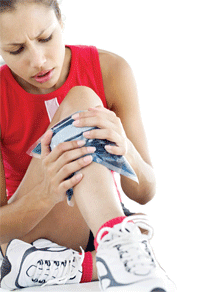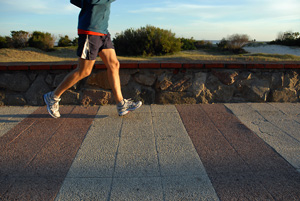 Running isn’t easy. At times it hurts. When the pain is more than the typical sore muscles and fatigue, there’s a problem. Thankfully there are answers. More often than not, the problems stem from the runner and not the activity itself.
Running isn’t easy. At times it hurts. When the pain is more than the typical sore muscles and fatigue, there’s a problem. Thankfully there are answers. More often than not, the problems stem from the runner and not the activity itself.
I’ve had my share of pains through out my running career and thankfully I’ve had the help of a physical therapist to work through them and find their cause.
Like so many other therapists, assistant professor of physical therapy and director of the running clinic at Washington University in St. Louis, Gregory Holtzman, is helping runners overcome the technique problems that may be hurting them. In an article from MSNBC, we learned that Holtzman evaluates and records runners in his clinic to pin-point the issues that they are struggling with. He finds that there are five common issues that runners are diagnosed with in relation to their struggles.
1. Asymmetrical running pattern
This pattern refers to the runner landing harder on one side than the other. If a runner lands harder on one side this tends to indicate a mechanical flaw in running style. This is a very typical cause for pain.
I know I have a dominant leg, and the longer the run, the more I rely on it. This caused more issues for me in the beginning of my career. As I grew stronger and more accustomed to running, I began to balance out more. Being an urban runner may have helped, too. I pass window fronts during my runs. Seeing my reflection during the run helps me see my flaws.
2. Inward knee collapse and weak hips
Weak gluteus muscles can cause runners’ knees to collapse inward while running. During a run, knees are supposed to stay in line with the hips. However, if the hip muscles are not strong enough to support body weight, that weight will call on the knees for support and cause bowing. Strengthening the glutes can resolve this common issue.
3. Running on your fore-foot when you’re really a rear-foot runner (and vice versa)
All runners naturally have a foot strike. They either are rear-foot strikers or fore-foot strikers. Rear-foot runners strike on the rear part of the foot. Fore-foot runners strike on the front of their foot. Neither type is better, but the impact of each is very different on the body.
For those having issues, a physical therapist can help make changes in body mechanics to reduce pain. These changes help reduce the impact force.
Fore-front running is in the news more due to the barefoot running trend. In order to run barefoot or in minimalist shoes a runner has to strike on the front of the foot and this presents issues for those who do no do so naturally. Holtzman describes that people must transition gradually so that they give their feet time to build strength.
I naturally strike on my fore-foot. I can’t imagine the difficulty of trying to change my natural foot fall. I know other runners who really fight through this issue. Once they’ve learned to make adjustment though, their whole running experience has improved.
 4. Over-striding and over-swinging
4. Over-striding and over-swinging
The mystery of back pain can be blamed on over-striding and over-swinging. Over-striding is the habit of taking steps that are too big for the body size. This action can cause the pelvis and spine to move more one direction than the other due to excessive rotation.
Over-swinging is when the runner swings one arm back further than the other. This habit can cause the spine to misalign.
I laugh when I read this because apparently I have a tiny stride. My physical therapist pokes fun at me, then he reminds me how tight my muscles are and smacks me for not stretching better. However, I know many runners struggle with this. With the help of therapy, a runner can make serious stride improvements.
5. Being unaware of your foot type
Just because the shoe looks awesome on the shelf, does not mean it’s the right shoe. Whether the runner has a flat foot, high arches, or even the rare perfect arch, proper footwear is a must. The hips, back, and knees are just a few of the places that can pay the painful price for poorly fitted shoes. Runners should go to a specialty store and be fitted verses going to a big box store.
I think this could be the number one issue I’ve ever encountered. Just today I received an email about how a friend’s stress fracture was caused by improper shoes. The first piece of advice my father gave me when he caught wind I was trying to run down the street and back without stopping, was to go get properly fitted for shoes at the running store.
By having the wrong footwear I have suffered unnecessary pain and injury. The big box stores offer better prices and sometimes cooler colors, but it is not worth the few bucks and the flashy hues. Heed this advice, get thee to a running store!
While Holtzman has chosen these five issues as the most common factors for a runner’s pain, other issues exist, or other pains can be chalked up to the same types of issues. I think his advice to any hurting runner is the crucial lesson to take away: He suggests going to a physical therapist for an evaluation.
Therapists have different eyes than us common Joes. They’re expertise can save you from all sorts of pain or worse… they can save you from having to stop running.
Also Read:
Quality Sleep Offers Injury Prevention
Fitness Injury 101 and the RICE Method
